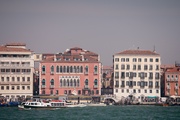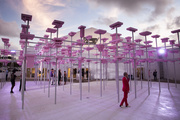Art Basel Unveils a Plan to Create New Cultural Capitals around the Globe

On Wednesday Art Basel announced a new initiative that will see the Swiss organization expand beyond its role of hosting the world’s preeminent art fairs in Basel, Miami Beach, and Hong Kong, to work with cities around the globe to create cultural programing aimed at placing them on the international art world map. Patrick Foret, Art Basel’s director of business initiatives, leads the new division, and will work with a team of advisors and experts including David Adjaye, Richard Florida, Jacques Herzog, Anne Pasternak, Patrizia Sandretto Re Rebaudengo, and Uli Sigg among others, to develop a bespoke program for each of the cities that Art Basel partners with.
“Art Basel has created cultural events and cultural programming for many years,” said Foret in an interview with Artsy. “We have a network of experts, an amazing team, and we have our exhibitors. What we are offering is to capitalize on all of this and to be an accelerator to propel cities’ cultural and economic development in a significant way.” Foret says they plan to work with cities for a period of two to five years, starting with a several-month audit of the city’s current cultural programming. “The approach is to go there, to sit down with each key stakeholder of the local art scene and also the city government and cultural officials to define with them a program that is aligned with their overall development in the mid and long term,” Foret added.
Art Basel has yet to announce the initial set of Art Basel Cities, however, Foret said that they are in advanced discussions with several potential partners. Additionally, in the three hours after the initiative was made public, two more cities requested to be considered for the program. Not all cities will be eligible. “There’s a certain number of boxes that need to be ticked,” said Foret. “The city has to be accessible; there needs to be a major airport; there has to be a cultural ecosystem,” comprised of museums and galleries, ideally with which Art Basel already has a relationship.
Most importantly, however, “the city must be committed to pushing out a cultural agenda in a significant way and have the ambition to become international.” This owes to the initiative’s intended monetization model, which will see them pull not from existing culture budgets (which are often too small to begin with), but instead from economic development budgets that might otherwise be used to fund major sporting events and stadiums or other growth initiatives. Art Basel does not intend to be an activist but rather a catalyst. “I’m not looking forward to going to cities spending a billion on sports and trying to convince them to do something different,” said Foret, “but I am looking forward to working with cities that have already made the decision and a conscious commitment that art is a good direction.”
The organization cites the significant economic impact that their fairs contribute to the cities in which they take place as the major value proposition to potential partner cities. Art Basel in Miami Beach, for example, generates an estimated half billion dollars of economic activity during its week-long stay in South Florida. With Art Basel Cities, they believe they can generate even greater impact through year-round lifts to the cultural fabric of their partner metropoles.
“People do not want to live in a boring place,” said Art Basel global director, Marc Spiegler. “That includes software developers, people in finance, and people of other interests that are not a part of the creative class; a city which is culturally vibrant is more attractive to every single type of talent that you need.” He added, “in a global economy, there is a constant global war for talent. A forward-thinking city will realize that investing in culture and the cultural life of its city is also an investment in the broader economic life of the city.”
Art Basel has yet to announce the initial set of Art Basel Cities, however, Foret said that they are in advanced discussions with several potential partners. Additionally, in the three hours after the initiative was made public, two more cities requested to be considered for the program. Not all cities will be eligible. “There’s a certain number of boxes that need to be ticked,” said Foret. “The city has to be accessible; there needs to be a major airport; there has to be a cultural ecosystem,” comprised of museums and galleries, ideally with which Art Basel already has a relationship.
Most importantly, however, “the city must be committed to pushing out a cultural agenda in a significant way and have the ambition to become international.” This owes to the initiative’s intended monetization model, which will see them pull not from existing culture budgets (which are often too small to begin with), but instead from economic development budgets that might otherwise be used to fund major sporting events and stadiums or other growth initiatives. Art Basel does not intend to be an activist but rather a catalyst. “I’m not looking forward to going to cities spending a billion on sports and trying to convince them to do something different,” said Foret, “but I am looking forward to working with cities that have already made the decision and a conscious commitment that art is a good direction.”
The organization cites the significant economic impact that their fairs contribute to the cities in which they take place as the major value proposition to potential partner cities. Art Basel in Miami Beach, for example, generates an estimated half billion dollars of economic activity during its week-long stay in South Florida. With Art Basel Cities, they believe they can generate even greater impact through year-round lifts to the cultural fabric of their partner metropoles.
“People do not want to live in a boring place,” said Art Basel global director, Marc Spiegler. “That includes software developers, people in finance, and people of other interests that are not a part of the creative class; a city which is culturally vibrant is more attractive to every single type of talent that you need.” He added, “in a global economy, there is a constant global war for talent. A forward-thinking city will realize that investing in culture and the cultural life of its city is also an investment in the broader economic life of the city.”
Lest anyone be mistaken, Art Basel does not plan to expand beyond its three current shows. “We aren’t going to start fairs; we aren’t going to start auction houses. Anything else is imaginable,” said Spiegler. That includes the regional fairs that its parent company, MCH Group, is currently in the process of acquiring. Though each program will be specifically tailored to the partner city, initiatives such as Art Basel in Hong Kong’s partnership with the ICC tower (this week, showing a work by Japanese artist Tatsuo Miyajima), the outdoor film program they host in Miami Beach, and Basel’s Art Parcours public art initiative give a taste of what could be in store. Foret has also been involved in the joint development of Art Basel brand partner initiatives such as the BMW Art Journey and the Davidoff Arts Initiative.
Regardless of the recipe, the impact must be long term. “We don’t want to do something that is a one-off and then the city goes back to where they were before Art Basel. We have to bring them to another level,” said Foret. Spiegler added that the collaborative nature of Art Basel Cities stands at the core of the initiative: “We’re not doing people’s culture for them, we’re doing it with them. The idea is to work with the city to develop something that’s coherent with its history, that’s coherent with its reality, that’s coherent with its future. There isn’t a ‘one size fits all’ solution.” And rather than a classical consultancy model by which they might deliver a plan and leave it for the city to execute, Art Basel will co-deliver all programming, adding both the weight of the 46-year-old brand and their expertise.
Ultimately, Art Basel hopes Cities will allow them to help create an art ecosystem globally that reflects their core values. “It allows us to support what we believe in,” said Spiegler. “Art Basel creates as many possibilities for as many artists all over the world as possible. That’s our job: to build patronage, private and public, for as many artists as possible.” Art’s reach is expanding beyond the confines of the core art world—those that attend, deal, and collect at Art Basel’s fairs and others—to a wide audience and to new parts of the globe. But little to no structure is currently in place to help that expansion take place in a way that fosters the very support structures through which artists are able to make and show their work. If Art Basel can build such a structure, it will be a legacy far greater than that which any art fair could ever achieve.
—Alexander Forbes
Regardless of the recipe, the impact must be long term. “We don’t want to do something that is a one-off and then the city goes back to where they were before Art Basel. We have to bring them to another level,” said Foret. Spiegler added that the collaborative nature of Art Basel Cities stands at the core of the initiative: “We’re not doing people’s culture for them, we’re doing it with them. The idea is to work with the city to develop something that’s coherent with its history, that’s coherent with its reality, that’s coherent with its future. There isn’t a ‘one size fits all’ solution.” And rather than a classical consultancy model by which they might deliver a plan and leave it for the city to execute, Art Basel will co-deliver all programming, adding both the weight of the 46-year-old brand and their expertise.
Ultimately, Art Basel hopes Cities will allow them to help create an art ecosystem globally that reflects their core values. “It allows us to support what we believe in,” said Spiegler. “Art Basel creates as many possibilities for as many artists all over the world as possible. That’s our job: to build patronage, private and public, for as many artists as possible.” Art’s reach is expanding beyond the confines of the core art world—those that attend, deal, and collect at Art Basel’s fairs and others—to a wide audience and to new parts of the globe. But little to no structure is currently in place to help that expansion take place in a way that fosters the very support structures through which artists are able to make and show their work. If Art Basel can build such a structure, it will be a legacy far greater than that which any art fair could ever achieve.
—Alexander Forbes



No comments:
Post a Comment